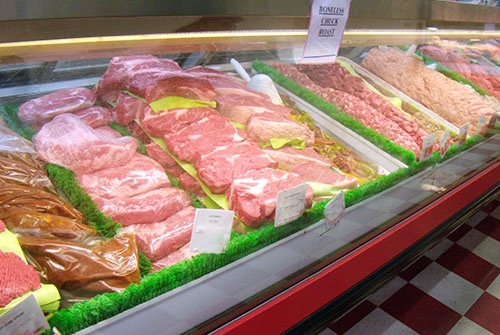What Makes Bagley Farms Meat Market Edwardsville IL Stick Out for Meat Lovers
What Makes Bagley Farms Meat Market Edwardsville IL Stick Out for Meat Lovers
Blog Article
Reveal the Art of the Butcher's Cut in a Modern Meat Market
In the ever-evolving landscape of contemporary meat markets, the butcher's cut has transcended its traditional origins, merging olden craftsmanship with modern techniques. What truly sets the modern-day butcher apart is their capability to build a deeper link in between customers and the origins of their meat.
Evolution of Butchery Methods

The mid-20th century saw butchery techniques even more improved by clinical understandings into muscle mass biology and meat aging, boosting both inflammation and taste. Developments like vacuum cleaner packaging and refrigeration expanded product shelf-life, allowing butchers to diversify offerings and enhance quality assurance. This duration also marked the increase of customized tools, such as band saws and meat slicers, which raised accuracy and effectiveness in meat processing.
The 21st century has actually presented digital innovation into the butchery world. Computerized systems now help in tracking pet provenance and optimizing cuts to meet certain customer preferences. In addition, a rebirth in artisanal butchery has actually arised, blending standard abilities with contemporary understanding to deal with customers seeking ethical and lasting meat options. This evolution highlights a vibrant interplay between practice and development, meeting modern needs while preserving the craft's heritage.

Recognizing Meat Cuts

Recognizing the intricacies of meat cuts is important for both butchers and customers seeking top quality and worth. For butchers, exact cuts mirror ability and regard for the craft, ensuring very little waste and optimum yield.
The key classifications of meat cuts include primal, sub-primal, and retail cuts. Butchers after that damage these down better right into sub-primal cuts, prior to ultimately generating retail cuts available to customers, like ribeye or tenderloin.
Recognizing muscular tissue structure is crucial; muscle mass utilized a lot more regularly by the animal tend to be harder and are best fit for slow-moving cooking techniques, while less-used muscles, like those located in the loin, are more tender and suitable for grilling or roasting. Familiarity with these differences equips customers to make educated selections, boosting their culinary endeavors.
Selecting Quality Meat
Choosing the best meat entails greater than simply selecting an aesthetically attractive item from redirected here the screen. The art of choosing high quality meat needs a critical eye and knowledge of details characteristics that symbolize quality and excellence. Firstly, focus on the color; beef should have an intense, cherry-red color, while lamb needs to display a soft pink tone, and pork a light pink. This shows the meat is fresh and hasn't been exposed to oxygen for too lengthy.
Second of all, take into consideration the marbling, which refers to the white streaks of fat within the muscle. Correct marbling is a vital indication of inflammation and flavor, as it melts throughout cooking, boosting the meat's juiciness. Bear in mind, greater marbling often correlates with exceptional quality cuts, such as USDA Prime.
Texture is one more critical aspect; meat must feel firm to the touch, not slimy or overly soft. In addition, be conscious of the scent. Fresh meat needs to have a clean, neutral scent, devoid of any type of sour or off-putting smells.
Pairing Cuts With Food Preparation Approaches
Effectively pairing cuts of meat with the ideal food preparation methods is important for achieving optimum flavor and texture. These techniques enhance the meat's natural tastes and make certain a juicy coating.
Conversely, harder cuts like brisket and chuck roast are abundant in collagen, which damages down right into jelly when prepared gradually. These cuts are excellent for braising or slow roasting, allowing the meat to soften in time image source and create deep, intricate tastes. Cuts such as brief ribs and pork shoulder fare well with slow-cooking approaches, where extended cooking times transform their durable appearances right into succulent dishes.
Lamb shanks and oxtail, which call for prolonged cooking to soften, are ideal candidates for cooking or slow-moving simmering. These methods coax out abundant, hearty flavors while keeping wetness. By recognizing the one-of-a-kind attributes of each cut, cooks and home cooks alike can raise their culinary developments, ensuring each dish is both pleasing and remarkable.
The Butcher's Role Today
Navigating the advancing landscape of the modern-day meat market, the butcher's role today expands past mere preparation of cuts. Contemporary butchers are culinary artisans, teachers, and advocates for lasting practices. They connect the space between the farm and the fork by making certain moral sourcing, understanding animal husbandry, and prioritizing openness in the supply chain. This change shows the growing consumer demand for quality over quantity, where provenance and pet welfare are paramount.
Along with crafting precise cuts, butchers currently engage straight with consumers, providing cooking recommendations and customizing choices to suit specific needs and preferences. Their Homepage proficiency in meat aging, marbling, and flavor accounts encourages customers to make informed decisions, enhancing their culinary experiences. This personalized service exhibits the butcher's evolving duty as a relied on expert in the kitchen area.
Moreover, butchers are pivotal in reducing waste, making use of whole pets to produce varied items such as sausages and supplies - bagley farms meat market edwardsville il. This thorough strategy not only values the animal however likewise aligns with modern sustainability goals. In this means, the contemporary butcher embodies both custom and technology, adapting to an ever-changing market while preserving the creativity and stability of their craft

Verdict
Mastery in understanding varied meat cuts and quality indicators encourages butchers to provide educated referrals, aligning specific cuts with optimum cooking methods. By honoring historical practices while accepting contemporary demands, the butcher's function continues to be essential in today's advanced meat market.
Report this page